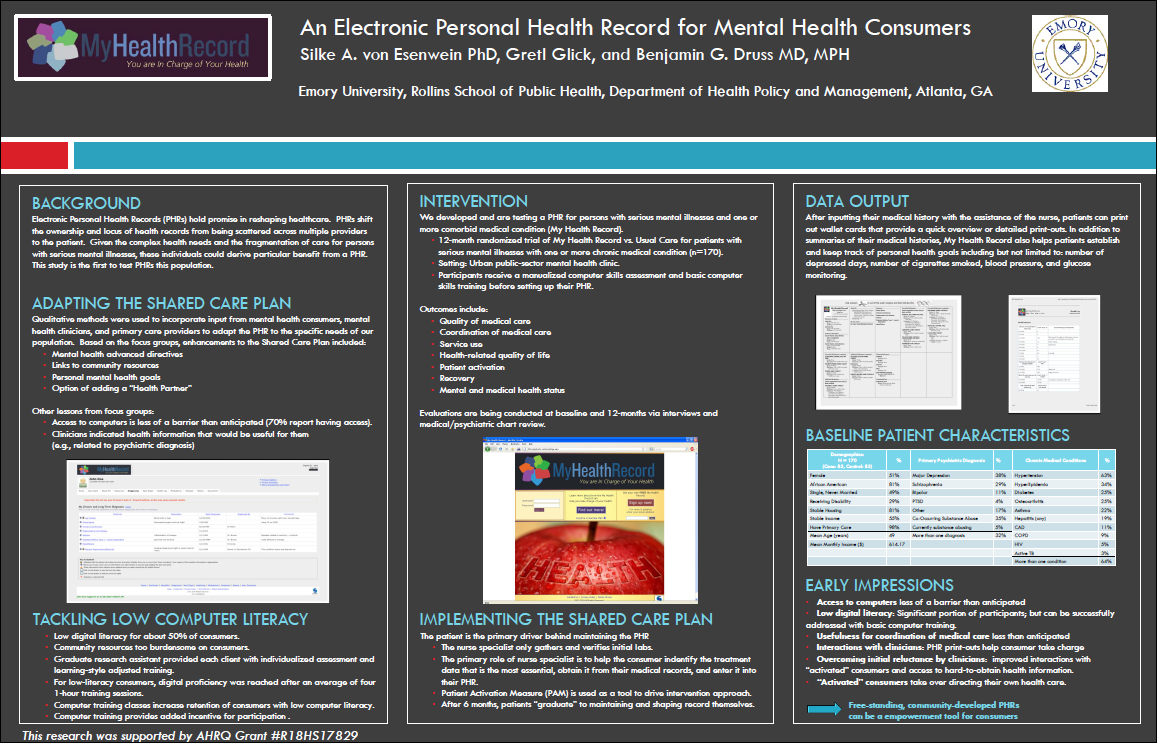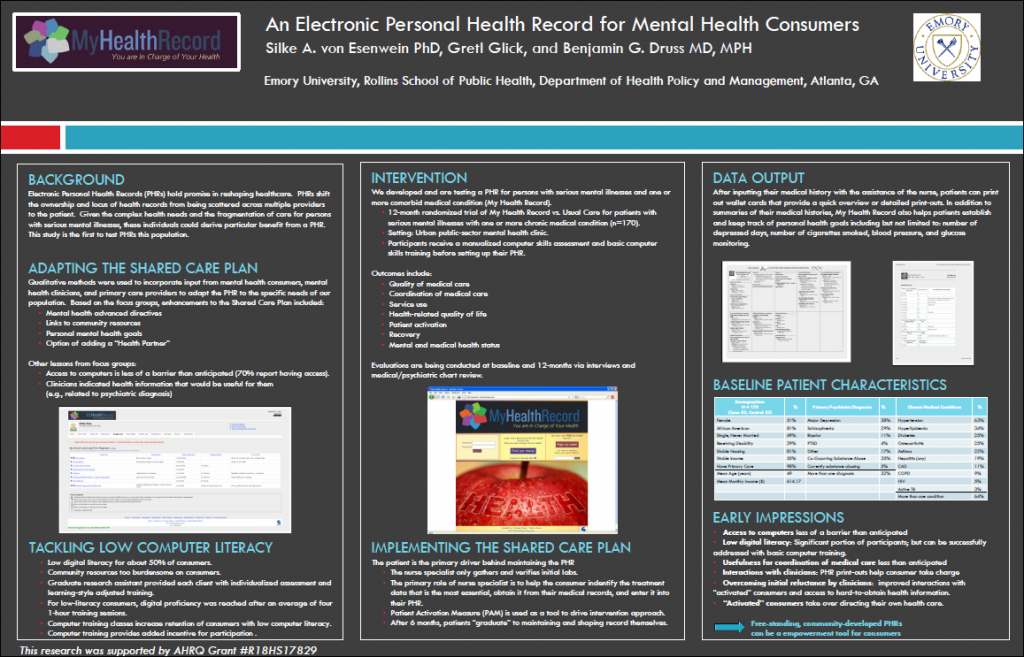The Society for Participatory Medicine was well represented last week at the 14th ICSI/IHI Colloquium. (ICSI is the Institute for Clinical Systems Improvement, a small midwestern think tank that’s way too poorly known.) SPM members who presented:
- Jane Sarasohn-Kahn of Health Populi gave the keynote for Day 2
- Jessie Gruman, four time cancer patient and founding co-editor of our journal, gave an important breakout session, about which I’ll be writing soon. (Jessie is founder and president of the excellent Center For Advancing Health.)
- Brian Ahier presented on the status of health IT, as Meaningful Use rolls out. (“You can’t measure the improvements that you gotta measure, unless you have computers keeping track of it.”)
- I gave a half-day pre-conference workshop titled “Participatory Health: Reshaping Patient Care.” I’m told the workshop had 40-50% higher registration than usual: interest in participatory medicine is strong.
An unexpected bonus was that right outside the workshop door, a poster presentation addressed some questions people often ask about patient participation and online health records:
- Will patients with problems actually use a PHR (personal health record)? (Many observers say PHRs are a non-starter, a pointless exercise.)
- Especially, will poor people use one?
- Obviously, most don’t even have a computer.
- Plus, computer literacy is necessary, and education levels among the poor are statistically lower. Frankly, are such people smart enough? (Many observers won’t come out and say it, but in my experience that’s what it boils down to.)
- Note: People in lower socio-economic tiers are often referred to as “safety net” populations – they can’t afford insurance, so the only care they get is whatever “safety net” their state or region provides.
- What about people with mental diagnoses – substance abuse, depression (low motivation?), etc.?
Those are the questions examined by this project, produced by an Emory University team headed by Benjamin Druss, MD, MPH and funded by a grant from AHRQ (Agency for Healthcare Research and Quality). They studied a population of safety net patients with at least one mental illness diagnosis and one or more additional conditions (co-morbidities).
Final results (including health outcomes) won’t be available until this fall, but clear evidence has emerged about PHR use (and benefits). Here’s the poster. Click to view PDF, 420k:
The early impressions (bottom right) caught my attention: (emphasis added)
- Access to computers less of a barrier than anticipated
- Low digital literacy: Significant portion of participants; but can be successfully addressed with basic computer training.
- Usefulness for coordination of medical care [is] less than anticipated
- Interactions with clinicians: PHR print-outs help consumer take charge
- Overcoming initial reluctance by clinicians: improved interactions with “activated” consumers and access to hard-to-obtain health information.
- “Activated” consumers take over directing their own health care.
- “Activation” was assessed using the well known PAM (Patient Activation Measure) test, developed at the University of Oregon and currently marketed by Insignia Health. (See the behaviors that are said to be predicted by PAM.)
I seized the opportunity to speak with Emory’s Silke von Esenwein PhD, who was there; she was lead author on the poster. I pulled out my Flipcam and did a very rough, quick hallway interview. (The ringing sound at the start is the hallway chimes, as we were called back into session.)
I’m fascinated with the evidence that computer access is less of a barrier than anticipated. But it’s not a shock:
- Last month SPM member Ted Eytan MD showed me a snapshot of “safety net” people in his neighborhood, occupying every single computer the local library has.
- Last November John Moore at Chilmark Research posted Smashing Myths & Assumptions: PHR for Urban Diabetes Care, which documented that for the urban poor, their handheld is sometimes their “medical home.” (And they use it!)
Silke agreed with the off-the-cuff remark at the end of the video:
Many people believe it’s just not imaginable that people who don’t have a good life could be good at this.
It’s too early to draw firm conclusions from this study, and any study should be replicated (though much medical research never is). But however well-meaning those concerns may be, it appears they’re superstitions, not science. So let’s get over that and get on with empowering, equipping and enabling our citizens, so they can be engaged in their care. [Update: see our 2014 post for the final paper]
All our citizens. With nobody left out.
_______
p.s. The PHR used in the study was “My Health Record,” which was adapted by Emory for this purpose from Shared Care Plan, a free county-wide PHR in Whatcom County, Washington. What would be possible if everyone you know had access to such a tool? (Here’s the punch line: free PHRs do exist.)
Are you a member of the Society, supporting our work and participating in our member-only listserv? It’s only $30. Is your company a member, providing greater support? Join here.








Thanks for posting this, Dave.
If people have any follow-up questions or want more details, they can ask me here or contact me directly at svonese@emory.edu.
Silke
Dave, may I remind you that during the lectures on ISDM in Salzburg we were shown how safety net populations are very apt in using health information on their handhelds or on game platforms and that in Africa mHealth is thriving even among illiterate populations since mobiles are the only means to reach a HCP and therefore appropriate apps were developed.
My concern though is not so much digital literacy as health literacy, which at the root of the problem. Even if appropriate PHR apps are developed people need to grasp the basics of health literacy. So if I were to put in line the Es of the participatory medicine, I would re-oprder with enabling, empowering, equipping, engaging.Enabling meaning getting the necessary basic skills to take care of one’s health.
I would agree with that. We are actually measuring literacy (reading level), digital literacy, and health literacy in our study to see how they correlate and what kind of impact they have on PHR usage and outcomes.
Although the final data collection will not be finished until the fall, I can tell you that it appears that building/using the PHR and learning how to find good information on the internet had an impact on our participant’s health literacy.
There were several ways we tried to achieve this:
1. When participants enter a diagnosis or a medication, an immediate link was created that would take them to good internet resources.
2. The nurse specialist who helped them set up the PHR initially, would spend a good amount of time educating patients about their chronic conditions, their medications, what kind of services they are supposed to be getting, and how to communicate with their clinicians.
For a number of our participants, that was the first time somebody had even given them the most basic info about their conditions and what a treatment plan could look like.
3. One of our computer teaching modules covered how to find reliable, easy-to-understand health information on line, and how to look up terms that are foreign.
Kathi, thanks for any and every reminder you can give me of that extraordinary week in Salzburg. At least 1/3 of it went over my head and another 1/3 of it needs reminders like this.
The reality here in the US is that way too many people still think online (or handheld) health tools will not be adopted by lower tiers of people. We’re happy here to post everything we can find about that – if you have links or want to write something, by all means do.
I know there are policy people in Washington who read this blog, so the effort isn’t wasted. (Hint hint.)
In other words, a PHR can be a powerful tool to overcome health literacy.
Hi Silke, I see great interest in the research you do. Besides my health advocacy interests, I am also professionally interested in digital literacy which I link to my health advocacy interests. So for me it is digital AND health literacy that can make a difference, given that nowadays almost all medical info is available mostly online.
May I point out to you an interesting tweetchat #healthlit in which I regularly participate. It has to be noted that the participants are key stakeholders in health literacy policies and implementation from the US with significant participation from Europe and other areas. The moderators are HealthLiteracy Missouri http://www.healthliteracymissouri.org/.
Interesting, thanks for pointing that out.
Thanks, Dave! Fantastic post.
Half of the magic of blogging is facilitating a discussion like this one, where we get to hear directly from experts like Silke & Kathi.
The other half, of course, is that we may never have heard of the study if Dave hadn’t stopped to report on it and add his own thoughts.
I’ll add a few more links in case anyone wants to pursue this topic further:
“Crossing The Digital Divide with Connected Health”
http://chealthblog.connected-health.org/2011/05/10/crossing-the-digital-divide-with-connected-health/
“A Health Information Divide”
http://pmedicine.org/epatients/archives/2011/02/a-health-information-divide.html
“What people living with disability can teach us”
http://pmedicine.org/epatients/archives/2011/01/what-people-living-with-disability-can-teach-us.html
Not safety-net related, but today’s example of a study showing the benefit of health data access:
“Cancer Patients Benefit From Full Access to Medical Records”
http://news.yahoo.com/s/hsn/20110523/hl_hsn/cancerpatientsbenefitfromfullaccesstomedicalrecords
Suzannah you read my mind! I just came back from a meeting of the Strategic Committee for Digital Greece 2020 (a forum that works on strategy/proposals for the implementation for the EU Digital Agenda 2020 policies http://ec.europa.eu/information_society/digital-agenda/index_en.htm – every EU member country also works on its own digital agenda).
Among the various topics/proposals discussed tonight was indeed the digital divide. You bet that I insisted that the group working on this issue includes health literacy in digital literacy. I quoted the EU policies on health literacy, how important is health literacy for better health outcomes, for ISDM and what we discuss at the #healthlit and invited my colleagues (University professors, geeks and policy makers) to participate.
Therefore, you understand that I am very nicely surprised of the coordination between Dave’s post, Silke’s and your comments from two far out points on earth on the same topic! That’s the beauty of the internet and the social media!!
You guess what is my next step: to send a mail to my colleagues in the committee with your links, the pew report on use of internet for health info and transcripts of the #healthlit kept by Health Literacy Missouri so that they learn what is done and said elsewhere. It’s unbelievable how small the global village has become!
After all the EU has signed a memorandum of understanding with the USA on e-health so more and more info will travel hin and forth!